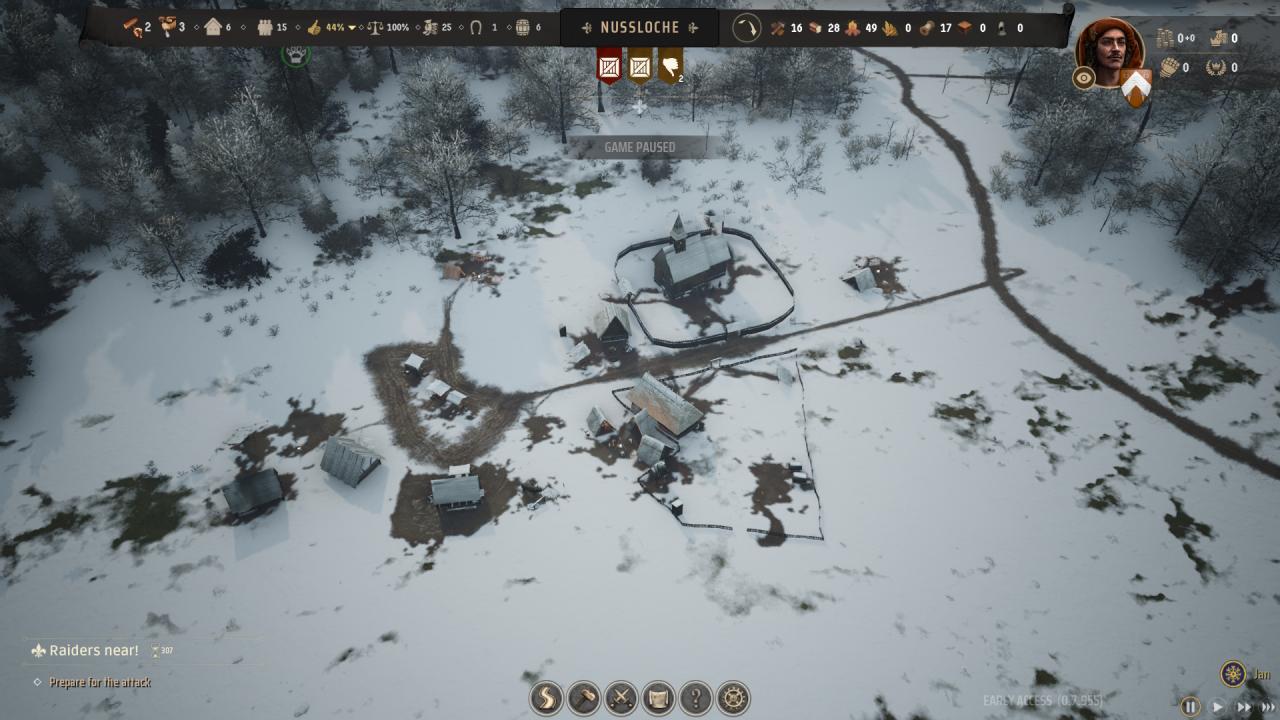A fast start guide for intermediate players, people who can make a town when given time, but struggle to quickly become happy and draw immigrants on higher difficulties.
How far are we going with this build?
This build takes you until your first immigrants arrive and you can start expanding and building properly.
I’ll explain how to start, and how to adapt things for challenging difficulty, but once you start looking at your natural resources and thinking about allotting development points this guide is no longer relevant, I trust you to know how to capitalize on your natural resources and develop.
The challenges
So getting immigrants on higher difficulties can take some time if you don’t know what you were doing, as there are some bottlenecks the game throws at you, and not all of them are intuitive.
To understand why this works, I’m going to point out the core mechanics that actually make the early game tough.
- A quarter of each months happiness gets remembered for about a year, so ending homeless and going hungry for too long can hurt you dearly.
- The ox is a major bottleneck. A lot of your build time will be wasted if you build your logging camp too soon, as your workers will, instead of bringing wood to construction sites, will haul the wood AWAY FROM THE CONSTRUCTION SITES then do a second hauling job. This is to say, they play ox racing to sit on their hands not building. So like, you will be a month behind if you let them do this.
- On challenging you need two food types when you have very few workers. Chickens are passive, so while we will use a workers camp, we also do need to build one early burgage.
- Markets will serve an empty house before a full worker camp. Your settlement can be killed by a single bad burgage placement. You can have fun experimenting with the ways of instantly killing your camp if you want, but I explain roughly how to avoid this.
- Dedicated storage sites eat work, but give nothing.
This is important to understand, as this will be important to you if you want to do better then this. (I have yet to see one faster at gaining immigrants then this, but you might beat me here with proper knowledge!) The games still jank, but the potential is there.
So the quick strategy here is ending hunger, coldness, godlessness, and clotheslessness as fast as possible, while meeting the restrictive challenging happiness bottleneck early in the second month.
THIS MEANS IMMIGRANTS IN FEBRUARY/MARCH.
The build
Pause.
Place a market with space for exactly three stalls. Ideally, it should be between your resources, and your camp, but also near the kings road.
Place your hunting camp between your deer and your market.
Place a woodcutters lodge between your market and your forest.
Unpause and let these build.
Assign a worker to each.
Upgrade your homeless tents. Your food and fuel are now cutting down your unhappiness a lot and you should only have 1-2 points of remembered homelessness.
Build a tannery and assign a worker to this to resolve your clothing unhappiness.
Build your logging camp and assign two workers to it until you can fill the next step. Then bring it down to one worker once you can start.
IF YOU ARE ON CHALLENGING:
- Build a single burgage further from your market then the worker camp. If it is closer your people will have their food eaten by an empty house, and leave understandably frustrated.
- Put a chicken coop in it, this will provide eggs that your hunter will deliver to market, giving food happiness rather then anger.
- This will also double the resources in your market, but not change consumption, this lets you abuse the system and take your woodcutter off wood for a month once he stocks up the stall.
- This may be worth it on normal, but I haven’t properly tested it.
Build a sawmill and get to 25 planks with one worker on it, you need nobody building right now.
When you have enough planks, rush the rest of your logs for building the church.
Around mid January (On normal as april starts,) you should have your house of god. If your province shape was merciful, you might get immigrants as early as February… You can make a good militia with all those bodies, right?

If you can play the game on normal, getting enough weapons and growing your economy shouldn’t be too much of an issue once you have immigrants. Even if you don’t have the shipment.
Closing reasoning and disclaimer.
Starving and freezing to death are by far the biggest drains on happiness, followed by godlessness for a starting town.
So I solve the starving and freezing first. The bread takes too much time to save with a granary, and delays four other happiness sources to save so I just get two food sources that are good enough early on quickly.
However, the food and fuel can’t be used without some housing, with the workers camp being the cheapest. It might make sense to delete this later when you have homes, but its still a very fuel and clothing efficient piece of housing.
The tannery is a smaller source of happiness in my experience, but its so much easier to get then the church that its worth rushing first in my experience.
With all needs being covered, it should be pretty clear why we rush the church up quickly: Its simply the last obstacle between us and growth.
While all settlement locations can support an arbitrary number of level 2 houses if you plan things carefully, there is still a lot of jank so this needs its own guide.
